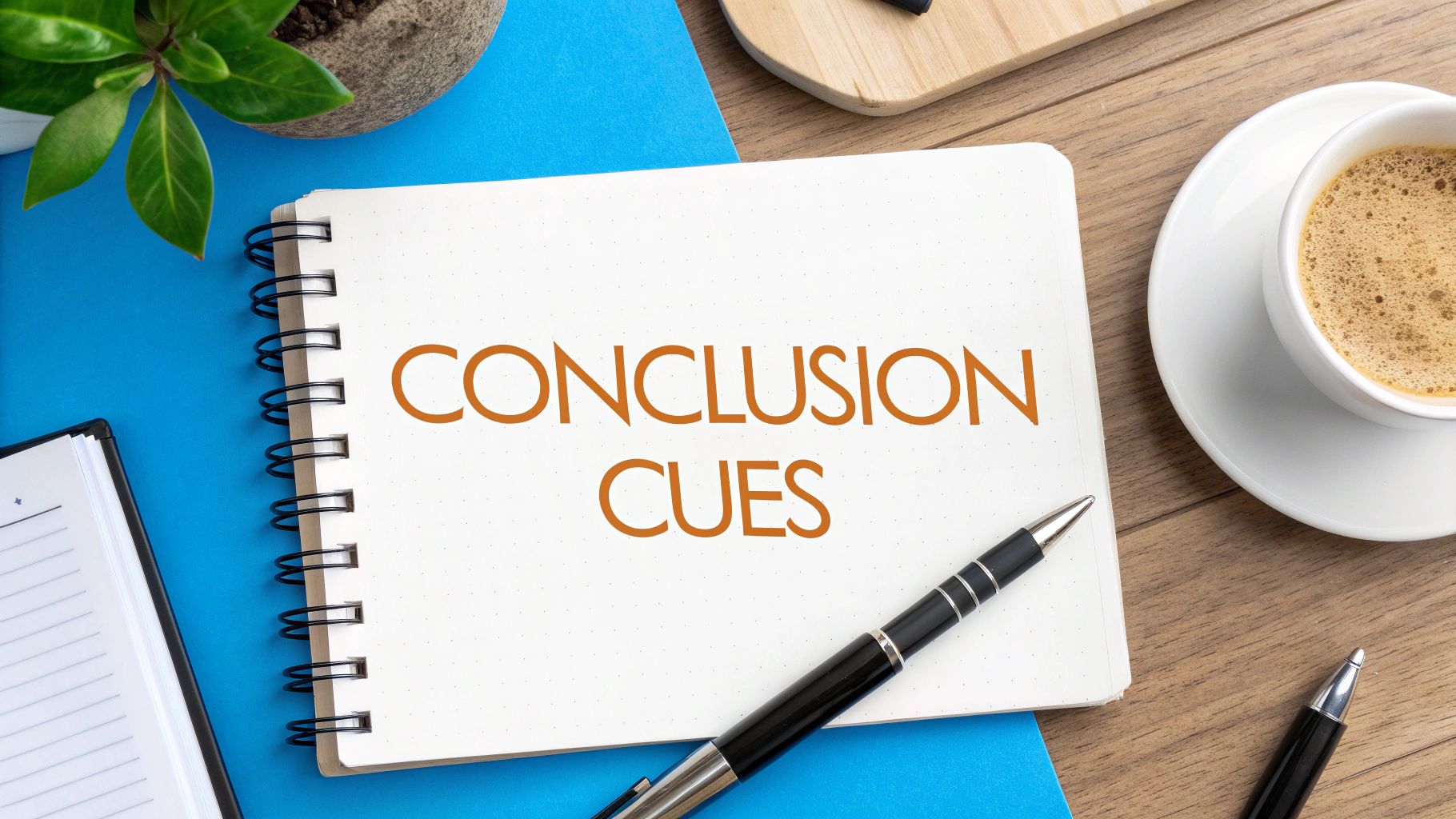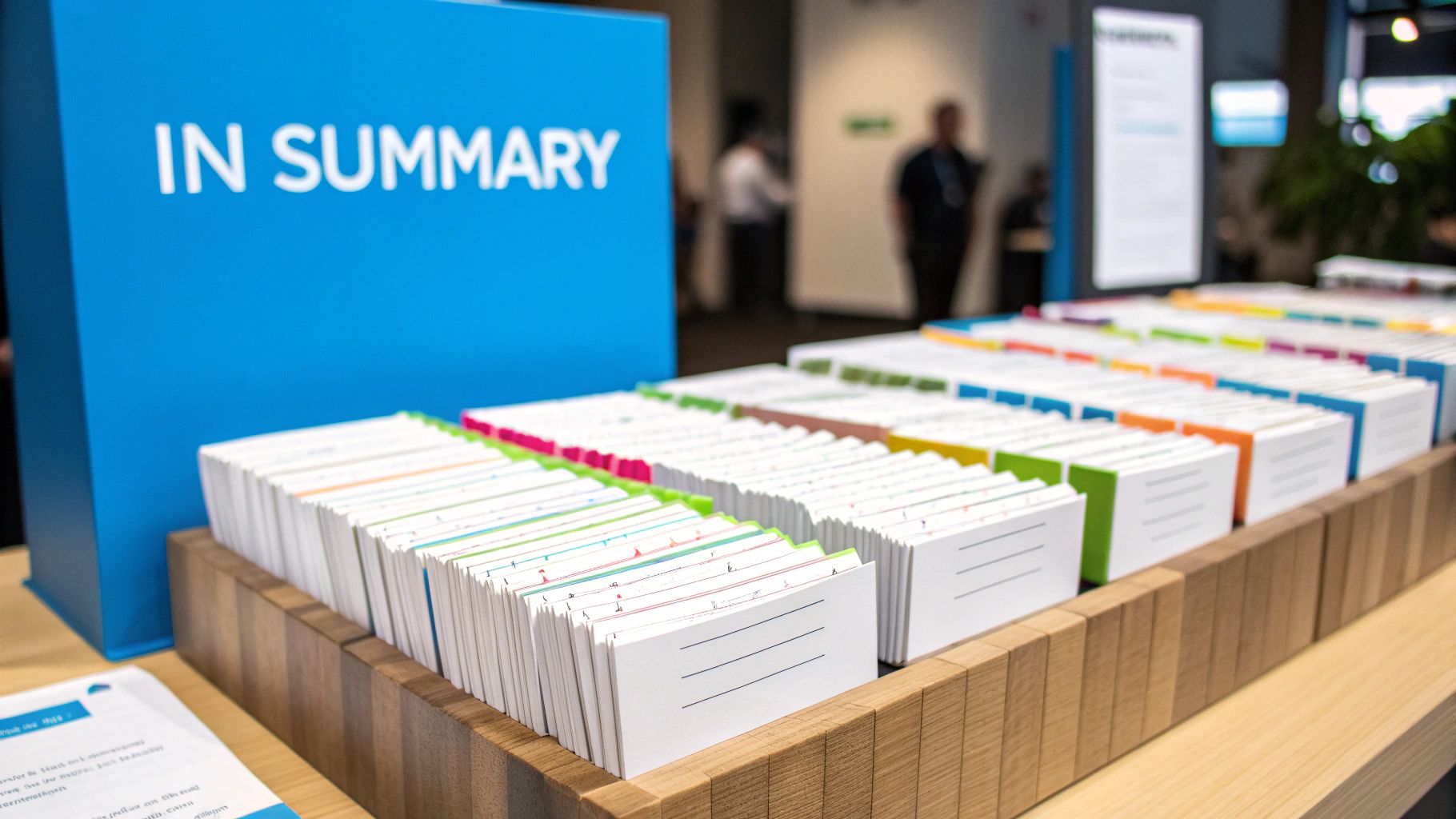8 Good Transitions for Conclusions: A 2025 Guide

The final sentences of your work are your last chance to persuade, inform, and leave a lasting impression. Yet, many writers stumble at this final hurdle, unsure how to gracefully signal the end without resorting to stale or repetitive phrases. A powerful conclusion doesn't just happen; it's engineered with a precise transitional phrase that sets the right tone and reinforces your core message.
This guide moves beyond the obvious, providing a versatile toolkit of good transitions for conclusions suitable for any writing situation, from academic papers to marketing copy. We will break down the subtle meanings behind eight effective phrases, explore their ideal contexts, and provide clear examples. You will learn how to select the perfect transition to ensure your final words resonate with your reader and achieve your intended impact, making your ending as strong as your opening.
1. In conclusion
"In conclusion" is arguably the most traditional and direct of all concluding transitions. Its primary function is to act as an explicit signpost for the reader, clearly indicating that the discussion is drawing to a close and the final summary or argument is about to be presented. This phrase establishes a formal tone, making it a reliable choice for structured writing where clarity and convention are paramount.
Because of its straightforward nature, it effectively eliminates any ambiguity. Your audience immediately understands they have reached the final thoughts, which helps them mentally prepare to synthesize the information provided. While some may view it as basic, its power lies in its universal recognition, making it one of the most dependable good transitions for conclusions in formal contexts.
When to Use "In conclusion"
This transition is best suited for formal and academic documents where a clear, unambiguous structure is valued over creative flair.
- Academic Writing: Ideal for research papers, essays, and dissertations where a formal tone is required.
- Professional Reports: Use it in business reports, technical documents, or proposals to signal the final analysis or recommendation.
- Formal Speeches: Helps an audience follow along and recognize the wrap-up of a presentation or speech.
Actionable Tips for Implementation
To use this phrase effectively, avoid making it feel repetitive or simplistic.
Pro-Tip: Pair "In conclusion" with a powerful and concise restatement of your thesis or main argument. Don't just list your points again; synthesize them into a final, compelling thought that leaves a lasting impression on the reader. For example: "In conclusion, the data overwhelmingly supports the hypothesis that renewable energy investments directly stimulate local economic growth."
2. In summary
"In summary" serves as a versatile and direct transition that signals a condensed restatement of the main points. It explicitly tells the reader you are about to provide a brief recap of key arguments or findings. This phrase is less formal than "In conclusion" but maintains a professional tone, making it ideal for longer or more complex pieces where the audience would benefit from a reinforcement of the central themes.
This transition is effective because it manages reader expectations, preparing them for a concise overview rather than a completely new thought. It promises clarity and brevity, which is especially valuable after a detailed discussion. Using "In summary" is one of the most reliable ways to craft good transitions for conclusions that prioritize clear, digestible takeaways for your reader.
When to Use "In summary"
This phrase is best used when your primary goal is to recap several distinct points clearly and concisely, ensuring the audience remembers the most critical information.
- Business Reports: Perfect for executive summaries or the final section of a project status report where stakeholders need a quick overview.
- Literature Reviews: Helps to condense findings from multiple sources into a coherent final statement in academic papers.
- Instructional Guides: Use it in training manuals to reinforce the key steps or lessons covered. While often used in academic contexts, the concept of summarizing is also crucial in professional documents. For a deeper dive into how summaries function in different settings, you might explore the distinct purposes of a resume objective versus a summary.
Actionable Tips for Implementation
To maximize the impact of "In summary," ensure it leads to a value-added synthesis, not just a simple list.
Pro-Tip: Follow "In summary" with a synthesized insight that connects your key points. Instead of just repeating them, show how they collectively support your main idea. For instance: "In summary, while the marketing campaign increased brand awareness and website traffic, its failure to boost conversion rates indicates a critical disconnect in the user journey that must be addressed."
3. To summarize
"To summarize" is an action-oriented transition that actively tells the reader what is about to happen: a distillation of the preceding information. It frames the conclusion as a concise recap, making it feel accessible and collaborative. This phrase suggests you are boiling down complex arguments or data into the most critical takeaways for the reader's benefit.
Unlike more formal alternatives, "To summarize" strikes a direct and engaging tone. It signals clarity and efficiency, promising to deliver the core message without extra fluff. This makes it an excellent choice for modern communication styles where brevity is valued, establishing it as one of the most practical good transitions for conclusions for both written and verbal delivery.
When to Use "To summarize"
This phrase is highly effective in contexts where clarity and reader engagement are more important than rigid formality. It's perfect for distilling information for a busy audience.
- Blog Posts and Articles: Works well to wrap up informative content by highlighting the key points for easy recall.
- Presentations and Speeches: Cues the audience that a concise recap is coming, which is helpful for retaining information.
- Training Materials: Ideal for concluding a module or workshop by reinforcing the main lessons learned.
- Consultant Reports: Use it in executive summaries to present the most crucial findings and recommendations clearly.
Actionable Tips for Implementation
Ensure this phrase introduces a genuine synthesis, not just a simple list of points already made. Properly condensing your arguments is key, and it’s important to give credit to original sources when doing so. This practice is a core part of academic and professional integrity, helping you learn how to avoid plagiarism.
Pro-Tip: Follow "To summarize" with a bulleted or numbered list of your most important takeaways. This visual break makes the conclusion exceptionally scannable and memorable. For instance: "To summarize, our findings indicate that: 1) Market entry is viable with a phased approach, 2) The primary target demographic is highly responsive to digital advertising, and 3) Initial investment will yield returns within 24 months."
4. Ultimately
"Ultimately" is a sophisticated transition that signals a conclusion reached after careful consideration of various factors or arguments. It implies a journey of analysis, suggesting that the final statement represents the most crucial, definitive takeaway. This phrase adds a sense of weight and finality, making it particularly effective for persuasive or analytical writing where multiple viewpoints have been explored.
Using "Ultimately" frames your conclusion not just as an ending but as the final verdict after weighing all evidence. It tells the reader that what follows is the core truth or the most important outcome of the discussion. This makes it one of the most powerful good transitions for conclusions when you want to convey a sense of deep thought and confident resolution.
When to Use "Ultimately"
This transition works best when your conclusion synthesizes complex information or presents a final judgment after exploring different sides of an issue.
- Persuasive Essays: Ideal for driving home your main argument after dismantling counterarguments.
- Strategic Analyses: Use it in business or policy papers to present the final, most critical recommendation.
- Philosophical or Complex Discussions: Perfect for concluding a piece that has navigated intricate ideas to arrive at a fundamental insight.
Actionable Tips for Implementation
To maximize the impact of "Ultimately," ensure the statement that follows carries appropriate significance.
Pro-Tip: Precede "Ultimately" with a brief acknowledgment of the complexities discussed. Then, deliver your most compelling, conclusive statement. This creates a powerful contrast. For example: "While market fluctuations and competitor actions present challenges, ultimately, the company's success will depend on its ability to innovate and adapt to consumer needs."
5. In essence
"In essence" is an elegant transition that signals a move from complexity to clarity. It tells the reader you are about to distill all the preceding information down to its fundamental truth or core message. This phrase is perfect for cutting through details to reveal the most critical takeaway, making it a powerful tool for summarizing intricate topics or reinforcing a central principle.
Using "in essence" suggests a thoughtful distillation of ideas. It conveys confidence and a deep understanding of the subject, assuring the audience that they are about to receive the most crucial insight. Because it focuses on the core message, it’s one of the most effective good transitions for conclusions when you want to leave a clear, memorable, and impactful final thought.
When to Use "In essence"
This transition excels in contexts where the goal is to simplify a complex argument or reveal an underlying theme without getting lost in minor details.
- Philosophical or Theoretical Discussions: Use it to summarize a complex chain of reasoning into a single, profound truth.
- Strategic and Vision-Based Content: Ideal for brand manifestos, business strategies, or leadership insights where you need to state the core mission.
- Cultural or Literary Analysis: Helps in revealing the central theme or a critic’s main argument after a detailed examination of a work.
Actionable Tips for Implementation
To maximize its impact, ensure the statement that follows truly captures the heart of your message.
Pro-Tip: Reserve "in essence" for when you are genuinely revealing the most fundamental point. The statement that follows should be concise, powerful, and free of jargon. For example: "In essence, despite their complex historical and cultural differences, both movements were fundamentally a cry for human dignity."
6. All things considered
"All things considered" is a thoughtful and comprehensive transition that signals a conclusion reached after careful deliberation. This phrase implies that the writer has weighed multiple factors, counterarguments, or pieces of evidence before arriving at a final, reasoned judgment. It conveys a sense of balance and analytical maturity, making it highly effective for nuanced discussions.
This transition is powerful because it acknowledges the complexity of the topic. Instead of presenting a simplistic finale, it assures the reader that all relevant aspects have been taken into account. This makes your conclusion feel more earned and persuasive, positioning it as one of the more sophisticated good transitions for conclusions available for analytical writing.
When to Use "All things considered"
This phrase is ideal for contexts where you have explored various sides of an issue and need to synthesize them into a single, cohesive takeaway.
- Policy Analyses: Perfect for summarizing the pros and cons of a policy before making a final recommendation.
- Product Reviews: Use it to conclude a review that has examined both strengths and weaknesses of a product or service.
- Strategic Recommendations: Effective in business proposals where multiple options or trade-offs have been discussed.
- Research with Mixed Findings: Helps in concluding academic papers where the data is not entirely one-sided.
Actionable Tips for Implementation
To maximize the impact of this phrase, ensure it reflects a genuine synthesis of the preceding discussion.
Pro-Tip: Precede "All things considered" with a brief acknowledgment of the complexity or competing factors discussed. Then, follow it with a clear and decisive final statement. For example: "While the initial setup costs are high and user adoption presents a challenge, all things considered, the long-term efficiency gains and competitive advantage make the new software a necessary investment."
7. As we have seen
"As we have seen" is a collaborative and evidence-based transition that frames the conclusion as a logical outcome of the preceding discussion. It creates a sense of a shared journey between the writer and the reader, referencing the evidence, examples, or arguments that have already been presented. This phrase suggests that the conclusion is not just an opinion, but a deduction rooted in the material covered.
This transition effectively reinforces the credibility of your argument by reminding the reader of the foundation you have built. It shifts the focus from simply ending the piece to synthesizing the presented facts into a coherent final thought. Because it directly links the conclusion to the body of your text, it stands out as one of the most compelling good transitions for conclusions when your argument relies heavily on previously shown proof.
When to Use "As we have seen"
This phrase is ideal for writing that methodically builds a case through evidence, data, or narrative examples.
- Case Study Analyses: Perfect for summarizing the findings of a detailed case study or report.
- Data-Driven Research: Use it in research papers or articles where you have presented data, charts, or statistics. For more insights on this, explore these research paper writing tips.
- Historical Narratives: Works well when concluding a historical examination where you've walked the reader through a sequence of events.
- Educational Content: Excellent for tutorials or educational articles that guide the reader through a process or concept step-by-step.
Actionable Tips for Implementation
To make this transition impactful, ensure it directly connects to tangible evidence you have already provided.
Pro-Tip: Follow "As we have seen" with a specific reference to the evidence and then state the insight derived from it. This shows you are not just summarizing, but interpreting. For example: "As we have seen from the consumer survey data, brand loyalty is intrinsically linked to post-purchase support, a factor many competitors overlook."
8. The key takeaway
"The key takeaway" is a modern and direct transition that frames your conclusion around its most critical, actionable insight. This phrase signals to the reader that you are distilling all the preceding information into one essential, memorable point. It shifts the focus from a simple summary to the practical value and real-world application of your message.
This approach is highly effective because it answers the reader's unspoken question: "What should I remember from all this?" By explicitly stating the takeaway, you enhance comprehension and retention, making it one of the most useful good transitions for conclusions in contexts where action or learning is the primary goal. It promises a concise and valuable final thought.
When to Use "The key takeaway"
This transition excels in content designed to inform, persuade, or educate, where leaving the reader with a clear, actionable point is crucial.
- Business and Marketing: Perfect for presentations, case studies, or reports where you want to emphasize a strategic insight or result.
- Educational Content: Use in training materials, workshops, and blog posts to reinforce the main lesson.
- Informal Articles: Works well in online articles or guides where you want to provide readers with practical, memorable advice.
Actionable Tips for Implementation
Ensure this phrase delivers on its promise of a significant insight, not just another summary point.
Pro-Tip: Make sure your key takeaway is genuinely the most important piece of information. It should be a powerful, standalone statement that encapsulates the core message. For example: "The key takeaway is that personalizing customer communication isn't just a tactic; it's a fundamental strategy that builds long-term loyalty and drives revenue."
Comparison of 8 Key Conclusion Transitions
| Transition Phrase | 🔄 Implementation Complexity | 💡 Resource Requirements | 📊 Expected Outcomes | ⭐ Key Advantages | ⚡ Ideal Use Cases |
|---|---|---|---|---|---|
| In conclusion | Low – straightforward to implement | Minimal – no special tools needed | Clear, formal closure | Universally recognized, formal tone | Formal academic & professional documents |
| In summary | Moderate – requires selecting key points | Moderate – may use lists or bullets | Reinforced understanding of main points | Flexible, suits various contexts | Longer documents needing clear recaps |
| To summarize | Moderate – active engagement required | Moderate – synthesis of info | Engaging, accessible synthesis | Conversational tone, promotes collaboration | Blogs, presentations, accessible writing |
| Ultimately | High – requires careful preceding analysis | High – deep analytical effort | Sophisticated, decisive conclusion | Suggests depth and thoughtful analysis | Complex, persuasive arguments and analyses |
| In essence | High – demands distillation of core ideas | High – insight and reflection | Clear core message | Elegant, clarifies complexity | Philosophical or strategic content |
| All things considered | High – balanced, multi-perspective analysis | High – weighing multiple factors | Reasoned, nuanced judgment | Balanced, credible approach | Complex topics with multiple viewpoints |
| As we have seen | Moderate – depends on strong prior evidence | Moderate – requires solid examples | Logical, evidence-based progression | Collaborative tone, evidence reinforcement | Data-driven or evidence-based writing |
| The key takeaway | Low – emphasizes clarity and actionability | Low to moderate – focus on insight | Memorable, actionable insight | Practical, modern, action-oriented | Business, education, and actionable content |
Beyond the Phrase: Weaving a Truly Memorable Conclusion
Mastering the art of the conclusion goes far beyond simply choosing from a list of good transitions for conclusions. While phrases like "In summary," "Ultimately," or "The key takeaway" provide a necessary signal to your reader that you are wrapping up, they are merely the signpost, not the destination. A truly powerful conclusion does not just repeat what has already been said; it synthesizes the core arguments, weaving them together to reveal a deeper meaning or a more significant insight. It’s the final lens through which your audience views the entire piece.
The most effective endings achieve three critical goals:
- Recap with Freshness: They briefly revisit the main points but reframe them with new language to avoid sounding redundant.
- Reinforce the "Why": They remind the reader why the topic matters, connecting the dots back to a larger context or a direct benefit.
- Provide a Final Thought: They offer a forward-looking statement, a call to action, or a memorable, thought-provoking idea that lingers long after the reader has finished.
Think of your conclusion as the final, compelling argument that cements your authority and leaves a lasting impression. It’s your last chance to transform your message from information into impact. While specific transition words are helpful, the art of a memorable conclusion also depends on your broader communication skills. Understanding how to improve your overall expression can help you craft more impactful and confident endings that resonate deeply with your audience. Ultimately, the goal is to make your conclusion feel both inevitable and profoundly satisfying, ensuring your message sticks.
Ready to elevate your writing from good to unforgettable? Word Spinner can help you find the perfect words to craft powerful conclusions. Use its advanced AI rewriting features to rephrase key points with clarity and impact, ensuring your final paragraphs are as strong as your first. Try Word Spinner today and make every conclusion a masterpiece.



